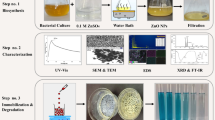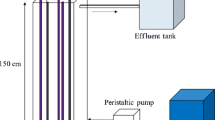Abstract
Cochlodinium polykrikoides (C. polykrikoides) is one of the most harmful red tide dinoflagellates due to its great economic damage and compromising recreational opportunity and public health. Titanium dioxide (TiO2) is known to be used as a photocatalyst for the control of the aquatic invasive algae under natural and artificial light. The purpose of this study was to design a highly efficient continuous photocatalytic reactor with TiO2-coated alumina for the demonstrated efficient degradation of C. polykrikoides. TiO2 photocatalyst beads were prepared by sol-gel dip-coating method using titanium tetra iso-propoxide on alumina. After 40 min of ultraviolet illumination time, the reduction of C. polykrikoides cell number was more than 80%. The degree of degradation of C. polykrikoides increased in a time-dependent manner in this novel reactor. The degradation begins with photocatalytic action by the oxidative species of TiO2 on the protective cell structures of C. polykrikoides.
Similar content being viewed by others
References
Kim, H. G., S. G. Lee, K. H. An, S. H. Youn, P. Y. Lee, C. K. Lee, E. S. Cho, J. B. Kim, H. G. Choi, and P. J. Kim (1997) Recent red tides in korean coastal waters. Nat. Fish. Res. Dev. Agency pp. 237-239.
Fukami, K., T. Nishijima, H. Murata, S. Doi, and Y. Hata (1991) Distribution of bacteria influential on the development and the decay of Gymnodinium nagasakiense red tide and their effects on algal growth. Bull. Jpn. Soc. Sci. Fish. 57: 2321–2326.
Fukami, K., A. Yuzawa, T. Nishijima, and Y. Hata (1992) Isolation and properties of a bacterium inhibiting the growth of Gymnodinium nagasakiense. Bull. Jpn. Soc. Sci. Fish. 58: 1073–1077.
Imai, I., Y. Ishida, and Y. Hata (1993) Killing of marine phytoplankton by a gliding bacterium Cytophaga sp., isolation from the coastal sea of Japan. Mar. Biol. 116: 527–532.
Imai, I., Y. Ishida, K. Sakaguchi, and Y. Hata (1995) Algicidal marine bacteria isolated from northern Hiroshima Bay. Fish. Sci. 61: 624–632.
Yoshinaga, I., T. Kawai, Y. Ishida, T. Takeuchi, and Y. Ishida (1995) Distribution and fluctuation of bacteria inhibiting the growth of a marine red tide phytoplankton Gymnodinium mikimotoi in Tanabe Bay (Wakayama Pref., Japan). Fish. Sci. 61: 780–786.
Kim, M. C., I. Yoshinaga, I. Imai, K. Nagasaki, S. Itakura, A. Uchida, and Y. Ishida (1998) A close relationship between algicidal bacteria and termination of Heterosigma akashiwo (Raphidophyceae) blooms in Hiroshima bay, Japan. Mar. Ecol. Prog. Ser. 170: 25–32.
Lovejoy, C., P. J. Bowman, and M.G. Hallegraeff (1998) Algicidal effects of a novel marine Pseudoalteromonas isolate (class Proteobacteria, gamma Subdivision) on harmful algal bloom species of the genera Chattonella, Gymnodinium, and Heterosigma. Appl. Environ. Microbiol. 64: 2806–2813.
Wang, S., H. M. Ang, and M. O. Tade (2007) Volatile organic compounds in indoor environment and photocatalytic oxidation: state of the art. Environ. Int. 33: 694–705.
Praveena, D. and T. Swaminathan (2003) Novel photoreactors for heterogeneous photocatalytic wastewater treatment. Ann. Chem. 93: 805–809.
Sharma, V. K., P. K. Dutta, and A. K. Ray (2007) Review of kinetics of chemical and photocatalytical oxidation of Arsenic(III) as influenced by pH. J. Environ. Sci. Health A: Environ. Sci. Eng. Tox. Hazard. Subst. Cont. 42: 997–1004.
Saien, J. and H. Neiati (2007) Enhanced photocatalytic degradation of pollutants in petroleum refinery wastewater under mild conditions. J. Hazard. Mat. 148: 491–495.
Hodgson, A. T., H. Destaillats, D. P. Sullivan, and W. J. Fisk (2007) Performance of ultraviolet photocatalytic oxidation for indoor air cleaning applications. Indoor Air 17: 305–316.
Fujishima, A. and K. Honda (1972) Electrochemical photocatalysis of water at semiconductor electrode. Nature 238: 27–38.
Wei, C., W. Y. Lin, Z. Zainal, N. E. Williams, K. Zhu, A. P. Kruzic, R. L. Smith, and K. Rajeshwar (1994) Bactericidal activity of TiO2 photocatalyst in aqueous media: toward a solar-assisted water disinfection system. Environ. Sci. Technol. 28: 934–938.
Wilkins, E., T. McDowell, and H. N. Pham (1995) Photocatalytically-mediated disinfection of water using TiO2 as a catalyst and spore-forming Bacillus pumilus as a model. J. Environ. Sci. Health A: Environ. Sci. Eng. Tox. Hazard. Subst. Cont. A30: 627–636.
Chun, M. J., E. Shim, E. H. Kho, K. J. Park, J. Jung, J. M. Kim, B. H. Kim, K. H. Lee, D. L. Cho, D. H. Bai, S. I. Lee, H. S. Hwang, and S. H. Ohk (2007) Surface modification of orthodontic wires with photocatalytic TiO2 for its anti-adherent and antibacterial properties. Angle Orthod. 77: 483–488.
Cai, R., Y. Kubota, T. Shuin, H. Sakai, K. Hashimoto, and A. Fujishima (1992) Induction of cytotoxicity by photo excited TiO2 particles. Cancer Res. 52: 2346–2348.
Kubota, Y., T. Shuin, C. Kawasaki, M. Hosaka, H. Kitamura, R. Cai, H. Sakai, K. Hashimoto, and A. Fujishima (1994) Photokilling of T-24 human bladder cancer cells with titanium dioxide. Br. J. Cancer 70: 1107–1111.
Matsunaga, T., R. Tomada, T. Nakajima, and H. Wake (1985) Photochemical sterilization of microbial cells by semiconductor powders. FEMS Microbiol. Lett. 29: 211–214.
Lee, D. K., M. S. Kang, S. C. Kim, and S. H. Woo (1999) Prohibition of the growth of algae in water with the TiO2 photocatalyst immobilized on the hollow glass beads. Appl. Chem. 3:200–203.
Lee, D. K., M. S. Kang, I. S. Chung, I. C. Cho, S. H. Woo, S. C. Kim, and S. W. Kim (2001) Photocatalytic inactivation of algal growth in eutropic water with hollow glass bead. Korean J. Chem. Eng. 18:889–893.
Peller, J. R., R. L. Whitman, S. Griffith, P. Harris, C. Peller, and J. Scalzitti (2007) TiO2 as a photocatalyst for control of the aquatic invasive alga, Cladophora, under natural and artificial light. J. Photochem. Photobiol. A: Chem. 186: 212–217.
Feitz, A. J., T. D. Waite, G. J. Jones, B. H. Boyden, and P. T. Orr (1999) Photocatalytic degradation of the blue green algal toxin microcystin-LR in a natural organicaqueous matrix. Environ. Sci. Technol. 33:243–249.
Guillard, R. R. L. J. H. Ryther (1962) Studies of marine planktonic diatoms. Can. J. Microbiol. 8: 229.
APHA (1998) Standard methods for the examination of water and wastewater, 20th ed. American Public Health Association, Washington DC, USA.
Zhong J. Q., B. Ryu, M. M. Kim, and S. K. Kim (2008) Free radical and reactive oygen species scavenging activities of the extracts from seahorse, Hippocampus kuda bleeler. Biotechnol. Bioprocess Eng. 6:705–715.
Hadi M. R., M. Shariati, and S. Afsharzadeh (2008) Microalgal biotechnology: carotenoid and glycerol production by the green algae Dunaliella isolated from the Gave-Khooni salt marsh, Iran. Biotechnol. Bioprocess Eng. 5:540–544.
Author information
Authors and Affiliations
Corresponding author
Rights and permissions
About this article
Cite this article
Shin, HJ., Kim, BH., Seo, H.S. et al. Degradation of Cochlodinium polykrikoides using photocatalytic reactor with TiO2-coated alumina. Biotechnol Bioproc E 14, 531–535 (2009). https://doi.org/10.1007/s12257-009-0048-5
Received:
Accepted:
Published:
Issue Date:
DOI: https://doi.org/10.1007/s12257-009-0048-5




